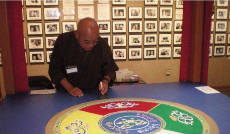The colors that are used in
the mandala, which is a circular
piece of art, are white,
green, red, blue, and yellow.
The white portion of the sand
piece represents water and
faces east, red represents fire
and faces west, green faces
north and symbolizes air and
yellow is facing south and represents
earth.
The center of the mandala is
blue and represents space.
There are flower designs on
the edges that symbolize the
continuity of the practice.
Samten said there is a
tremendous philosophy behind
the sand mandala, but mainly it
is to spread peace and kindness
among people around the
world. He also said the design
is over 26 centuries old.
In the middle of each colored
quadrant are intricate pieces of
art that hold several meanings,
one of them being a blessing
for the elements. The lotus in
the middle of the centerpiece
symbolizes kindness and purity.
The overall purpose of the
artworks in the middle are to
overcome the “five poisons” as
Samten calls them, which are
anger, ignorance, greed, ego
and jealousy.
There is also writing formed
in a circle around the center
which says, “Om mane pe me
hum” in Sanskrit lettering.
Samten said this is the mantra
of compassion which has to do
with generosity, ethics,
patience, concentration, wisdom
and effort. “All human
beings have these characteristics
within,” he said.
To create the intended
design, Samten uses two funnels,
each called a chak-pur.
These funnels have a small
hole at the end and ridges on
the side which he uses to
scrape together to let the sand
gently pass from the small exit.
He said that thousands of people
have touched those funnels
during art exhibits in museums
and any time he displays the
artwork.
Samten began learning how
to create the mandala because
he was fascinated with its rich
history. He said that the tradition
is now dwindling. Samten
was the first person to display
the mandala publicly in New
York in 1988. There are several
types that he has done such
as the mandala of time, which
he said is the largest, and the
wheel of life.
Samten said, “This is to
remind people the importance
of kindness and compassion in
our lives. Some ask me if I am
promoting Buddhism and I say,
‘No, I am promoting the
peace.'”
The making of the Mandala
NATASHA HARRIS
•
November 15, 2010


